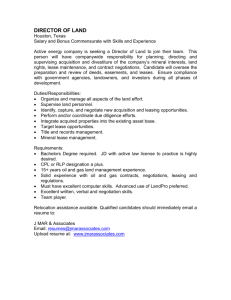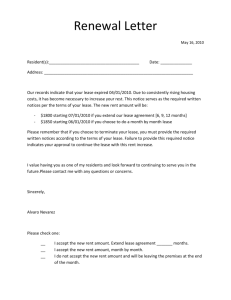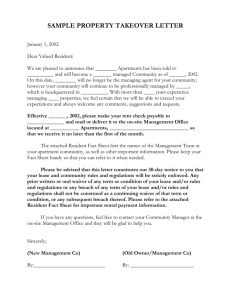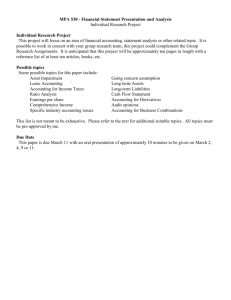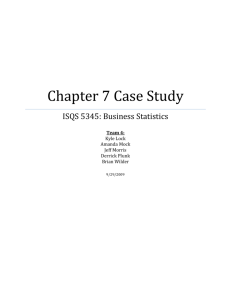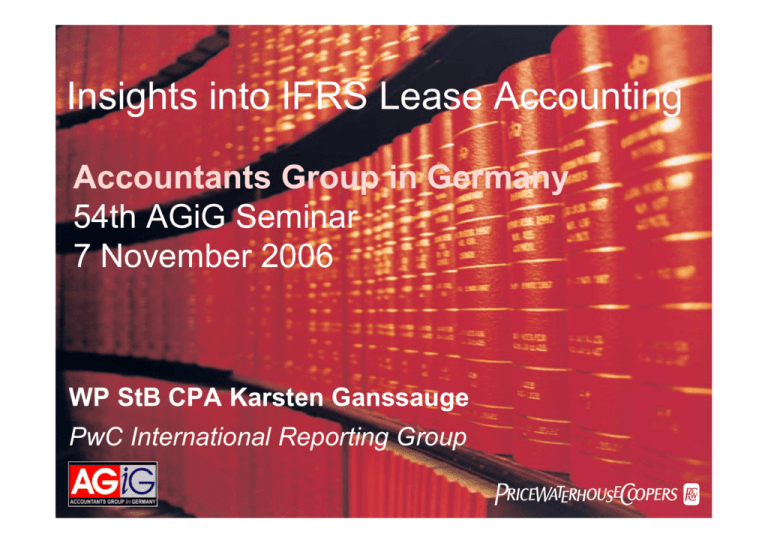
Insights into IFRS Lease Accounting
Accountants Group in Germany
54th AGiG Seminar
7 November 2006
WP StB CPA Karsten Ganssauge
PwC International Reporting Group
PwC
Agenda
IFRS Lease Accounting
US-GAAP Lease Accounting
German GAAP Lease Accounting
Section one
IFRS Lease Accounting
Lease Classification
Accounting Consequences of Lease Classification
Applications & Challenges in Practice
US-GAAP Lease Accounting
German GAAP Lease Accounting
Section one
IFRS Lease Accounting
Lease Classification
Accounting Consequences of Lease Classification
Applications & Challenges in Practice
US-GAAP Lease Accounting
German GAAP Lease Accounting
IFRS Lease Accounting - Lease Classification
Lease Classification - Relevant IFRS Guidance
• IAS 17 “Leases”
• Interpretations related to IAS 17:
- SIC-27 “Evaluating the substance of transactions involving the
legal form of a lease”
- IFRIC-4 “Determining whether an arrangement contains a lease”
• Other guidance, eg.
-
SIC-12 “Special Purpose Entities”
IAS 39 “Financial Instruments – Recognition and Measurement”
IASB Updates and IFRIC Updates
Related US GAAP guidance, eg. FAS 13 “Accounting for leases”
IFRS Lease Accounting
PricewaterhouseCoopers
September 2006
Slide 5
.
IAS 17.4
IFRS Lease Accounting - Applications & Challenges in Practice
Lease classification – what is a lease?
“A lease is an agreement whereby the lessor conveys to the
lessee in return for a payment or a series of payments the
right to use an asset for an agreed period of time”
Use of an asset
Lessee
Lessor
Cash
IFRS Lease Accounting
PricewaterhouseCoopers
September 2006
Slide 6
IFRS Lease Accounting - Lease Classification
IAS 17.7
IAS 17.8
IAS 17.10-.11
Lease Classification – IAS 17
“Classification of leases (…) in this Standard is based on the extent to which risks
and rewards (…) of a leased asset lie with the lessor or the lessee.”
Transfer of substantially
all risks and rewards?
Yes
No
Finance Lease
Operating Lease
Indicators for lease classification:
Ö IAS 17.10 (a)-(e), 17.11 (a)-(c)
IFRS Lease Accounting
PricewaterhouseCoopers
September 2006
Slide 7
.
IFRS Lease Accounting - Applications & Challenges in Practice
IAS 17.10-.11
Lease classification: Finance vs. Operating Leases
Indicators for lease classification:
IAS 17.10
(a) Transfer of ownership
(b) Bargain purchase option
(c) Lease term is for majority of economic life (>75%)*
(d) PV of MLP = at least subtantially all of the FV (>90%)*
(e) Specialised nature of leased asset
IAS 17.11
(a) Lessee bears costs of cancellation
(b) Gains/ losses from FV fluctuation accrue to lessee
(c) Bargain renewal option
* no bright line
IFRS Lease Accounting
PricewaterhouseCoopers
September 2006
Slide 8
.
IFRS Lease Accounting - Lease Classification
IAS 17.13
IAS 17.15
Lease Classification
• Lease classification is made at the inception of the lease
- unless change in the contractual terms
• Classification on an asset-by-asset basis
• Leases of land and buildings:
- Elements are considered separately for lease classification
- Allocation not based on relative fair values
- Land element is normally classified as an operating lease
unless title is expected to pass
IFRS Lease Accounting
PricewaterhouseCoopers
September 2006
Slide 9
.
IFRIC-4
IFRS Lease Accounting - Applications & Challenges in Practice
Lease classification – practical examples
Simplified SPE structure …
Leasing
Company
X%
Y%
Loan
Use of an asset
Lessor
SPE
Lessee
Bank
Cash
Cash
Often combined with:
• Hereditary building rights
• Purchase options
• Renewal options
• Financial guarantees
• etc.
IFRS Lease Accounting
PricewaterhouseCoopers
Asset
Cash
Manufacturer
September 2006
Slide 10
IFRIC-4
IFRS Lease Accounting - Applications & Challenges in Practice
Lease classification – other practical examples
Sale-leaseback-structures …
Finance or operating
Sublease
Sub-Lessee
Lessee
Cash
IFRS Lease Accounting
PricewaterhouseCoopers
Leaseback
Sale
Loan
Lessor
(SPE)
Bank
Cash
September 2006
Slide 11
IFRIC-4
IFRS Lease Accounting - Applications & Challenges in Practice
Lease classification – other practical examples
Indirect leases …
Manufacturer
Lease
Continuing
involvement*
Bank
Sale
Lessee
Cash
* e.g. buyback obligation or financial guarantee or remarketing agreement with profit sharing
IFRS Lease Accounting
PricewaterhouseCoopers
September 2006
Slide 12
Section one
IFRS Lease Accounting
Lease Classification
Accounting Consequences of Lease Classification
Applications & Challenges in Practice
US-GAAP Lease Accounting
German GAAP Lease Accounting
IFRS Lease Accounting - Accounting Consequences of Lease Classification
IAS 17.20-.57
Accounting Consequences of Lease Classification
Initial recognition - overview
Lessor
Lessee
Finance lease
Lease receivable
(@ net investment in the lease )
Asset (@ FV or lower PV of MLP)
plus lease liability
Operating lease
Asset
IFRS Lease Accounting
PricewaterhouseCoopers
September 2006
Slide 14
.
IFRS Lease Accounting - Accounting Consequences of Lease Classification
IAS 17.25-.32
IAS 17.39-.48
Accounting Consequences of Lease Classification
Subsequent accounting – Finance lease
Lessor
Finance lease Lease receivable
Subsequent
measurement
IFRS Lease Accounting
PricewaterhouseCoopers
• Split into finance income and
Lessee
Asset (@ FV or lower PV of MLP)
plus lease liability
• Split into finance charge and
reduction of liability
reduction of receivable
• Constant periodic rate of return • Constant periodic rate of return
• Finance charges + depreciation
September 2006
Slide 15
.
IFRS Lease Accounting - Accounting Consequences of Lease Classification
IAS 17.33-.35
IAS 17.49-.57
Accounting Consequences of Lease Classification
Subsequent accounting – Operating lease
Lessor
Operating lease
Asset
(presented according to nature)
Subsequent
measurement
• Lease income is recognised in
IFRS Lease Accounting
PricewaterhouseCoopers
Lessee
• Lease expenses are
P&L (normally straight-line)
recognised as an expense
over the lease term
• Costs incurred in earning the
lease income (incl. depreciation) (normally straight-line)
are recognised as an expense
September 2006
Slide 16
.
Section one
IFRS Lease Accounting
Lease Classification
Accounting Consequences of Lease Classification
Applications & Challenges in Practice
Classification: Finance vs. Operating Leases
SPE Consolidation Issues
Embedded Leases
US-GAAP Lease Accounting
German GAAP Lease Accounting
Section one
IFRS Lease Accounting
Lease Classification
Accounting Consequences of Lease Classification
Applications & Challenges in Practice
Classification: Finance vs. Operating Leases
SPE Consolidation Issues
Embedded Leases
US-GAAP Lease Accounting
German GAAP Lease Accounting
IFRS Lease Accounting - Applications & Challenges in Practice
IAS 17.10-.11
Classification: Finance vs. Operating Leases
Reminder: Indicators for lease classification:
IAS 17.10
(a) Transfer of ownership
(b) Bargain purchase option
(c) Lease term is for majority of economic life (>75%)*
(d) PV of MLP = at least subtantially all of the FV (>90%)*
(e) Specialised nature of leased asset
IAS 17.11
(a) Lessee bears costs of cancellation
(b) Gains/ losses from FV fluctuation accrue to lessee
(c) Bargain renewal option
* no bright line
IFRS Lease Accounting
PricewaterhouseCoopers
September 2006
Slide 19
.
IFRS Lease Accounting - Applications & Challenges in Practice
IAS 17.10-.11
Classification: Finance vs. Operating Leases
• Criteria individually or in combination normally point to the
existence of a finance lease
- Relevance of individual criteria
- Criteria are only indicators
• No straightforward “check list” to determine lease type unless
transaction is of a simple structure.
• Accounting policy manuals
IFRS Lease Accounting
PricewaterhouseCoopers
September 2006
Slide 20
.
IFRS Lease Accounting - Applications & Challenges in Practice
Classification: Finance vs. Operating Leases
IAS 17.10(b)
IAS 17.10(d)
IAS 17.11(b)
Common pitfalls
• Bargain purchase options
• Present value of minimum lease payments (MLP)
• Residual value gains/losses accruing to the lessee
Let’s take a closer look …
IFRS Lease Accounting
PricewaterhouseCoopers
September 2006
Slide 21
.
IFRS Lease Accounting - Applications & Challenges in Practice
IAS 17.10(b)
Classification: Finance vs. Operating Leases
Bargain purchase option
• Look at effect of option rather than on strike price only
- Example: option is at future fair value, combined with “penalty”
• “reasonably certain”
- look at probabilities based on strike price
- not other considerations, such as management strategy or other
non-risk/benefit-considerations
• If bargain purchase option:
- include strike price in MLP / “PV test”
- effects on distribution of gains and losses
IFRS Lease Accounting
PricewaterhouseCoopers
September 2006
Slide 22
.
IFRS Lease Accounting - Applications & Challenges in Practice
IAS 17.10(d)
Classification: Finance vs. Operating Leases
Present value of MLP
• FAS 13 indicator (90%), but cannot be applied as a “checklist”
• Often calculations do not include all relevant costs
• Watch out for terms & conditions outside of the lease contract!
-
transaction expenses
costs for operation of SPE (incl. income taxes)
general terms & conditions
stakeholdings in lessor SPE
• Potential problem in mass business (eg manufacturer lessors)
IFRS Lease Accounting
PricewaterhouseCoopers
September 2006
Slide 23
.
IFRS Lease Accounting - Applications & Challenges in Practice
IAS 17.11(b)
Classification: Finance vs. Operating Leases
Residual value gains/losses accruing to the lessee
• consider options
• watch out for agreements outside of lease contract
IFRS Lease Accounting
PricewaterhouseCoopers
September 2006
Slide 24
.
Section one
IFRS Lease Accounting
Lease Classification
Accounting Consequences of Lease Classification
Applications & Challenges in Practice
Classification: Finance vs. Operating Leases
SPE Consolidation Issues
Embedded Leases
US-GAAP Lease Accounting
German GAAP Lease Accounting
IFRS Lease Accounting - Applications & Challenges in Practice
SPE Consolidation Issues
SIC-12 - a “must consider” issue in many leasing transactions
•
•
•
•
Looking at lease classification under IAS 17 only has limited value
Consider whether lessor is consolidated
SPE = entity with “narrow and well-defined objective”
Interpretation of IAS 27 control model in SIC-12:
- “An SPE shall be consolidated when the substance of the
relationship between an entity and the SPE indicates that the
SPE is controlled by the entity”
- Consolidation may be required even if lessee does not hold any
voting rights!
IFRS Lease Accounting
PricewaterhouseCoopers
September 2006
Slide 26
IFRS Lease Accounting - Applications & Challenges in Practice
SIC-12.10
SPE Consolidation Issues
Indicators of control under SIC-12:
(a) in substance, the activities of the SPE are being conducted on behalf
of the entity according to its specific business needs so that the
entity obtains benefits from the SPE’s operation;
(b) in substance, the entity has the decision-making powers to obtain the
majority of the benefits of the activities of the SPE or, by setting up an
"autopilot" mechanism, the entity has delegated these decisionmaking powers;
(c) in substance, the entity has rights to obtain the majority of the benefits
of the SPE and therefore may be exposed to risks incident to the
activities of the SPE; or
(d) in substance, the entity retains the majority of the residual or ownership
risks related to the SPE or its assets in order to obtain benefits from its
activities.
IFRS Lease Accounting
PricewaterhouseCoopers
September 2006
Slide 27
.
SIC-12.10
IFRS Lease Accounting - Applications & Challenges in Practice
SPE Consolidation Issues
Qualitative vs. quantitative factors: Relationship and Models
Quantitative factors:
• Risks
• Rewards
Qualitative factors:
• Activities on behalf of entity
• decision making / autopilot
IFRS Lease Accounting
PricewaterhouseCoopers
September 2006
Slide 28
.
IFRS Lease Accounting - Applications & Challenges in Practice
SIC-12.10
IAS 39.21
SPE Consolidation Issues
Transfer of risks and rewards
Î No guidance in SIC-12!
Î What are risks and rewards?
Î Which risks and rewards are relevant?
Î What is meant by “transfer” of risks and rewards?
IFRS Lease Accounting
PricewaterhouseCoopers
September 2006
Slide 29
IFRS Lease Accounting - Applications & Challenges in Practice
SIC-12.10
IAS 39.21
SPE Consolidation Issues
• Risks and rewards – IAS 39
- “variability in the amounts and timing of the net cash flows of the
transferred asset”
- Upside (downside) potential from deviations between expected
and actual cash flows
• When is there a transfer?
- “An entity has transferred substantially all the risks and rewards
of ownership (…) if its exposure to such variability is no longer
significant in relation to the total variability in the present value of
the future net cash flows associated with the financial asset.”
IFRS Lease Accounting
PricewaterhouseCoopers
September 2006
Slide 30
SIC-12.10
IAS 39.21
IFRS Lease Accounting - Applications & Challenges in Practice
SPE Consolidation issues
only for demonstration
Probability
borne by lessee
purposes - not to scale
borne by the bank, the
dormant partner and the
general partner
4,800’
8,300’
Residual fair value in K€
9,195’
IFRS Lease Accounting
PricewaterhouseCoopers
E(RFV) = 9,200’
September 2006
Slide 31
IFRS Lease Accounting - Applications & Challenges in Practice
SIC-12.10
IDW RS HFA 2, Tz. 65
SPE Consolidation Issues – Reminders
When assessing risks and rewards, consider:
•
•
•
•
what is meant by risks & rewards?
which risks & rewards exist and which are relevant?
risks & rewards of entity vs. risks & rewards of leased asset
statistical analysis and expert opinions may be required!
IFRS Lease Accounting
PricewaterhouseCoopers
September 2006
Slide 32
IFRS Lease Accounting - Applications & Challenges in Practice
SIC-12.10
IDW RS HFA 2, Tz. 65
SPE Consolidation Issues - Reminders
Judgement required
• Often lessee will consolidate
• Sometimes the SPE is not (exclusively) designed to specifically
serve the purposes of one of the parties involved
• However, consider facts & circumstances if other parties involved in
setting up the SPE clearly bear the majority of risks & rewards
IFRS Lease Accounting
PricewaterhouseCoopers
September 2006
Slide 33
Section one
IFRS Lease Accounting
Lease Classification
Accounting Consequences of Lease Classification
Applications & Challenges in Practice
Classification: Finance vs. Operating Leases
SPE Consolidation Issues
Embedded Leases
US-GAAP Lease Accounting
German GAAP Lease Accounting
IFRS Lease Accounting - Applications & Challenges in Practice
IFRIC-4
Embedded Leases
Why accounting guidance for embedded leases?
• Contracts may have economic substance of a lease agreement, eg:
- purchase contracts
- servicing contracts
- outsourcing contracts
• Look out for specific assets where the entity receives substantially
all of the output of that asset
- Look at substance rather than form
- Such agreements may need to be accounted for as a lease
• Determining whether an arrangement contains a lease
- Defining the term specific asset
- Defining the scope of usage
IFRS Lease Accounting
PricewaterhouseCoopers
September 2006
Slide 35
IFRIC-4
IFRS Lease Accounting - Applications & Challenges in Practice
Embedded Leases
No
Assets within scope of IAS 17?
CONTINUE HERE
Yes
No
Specific asset explicitly identified?
No
Yes
No
Asset implicitly specified?
No
Yes
No
Fulfillment of arrangement dependent on use of specific asset ?
Yes
Yes
Purchaser has ability or right to operate the asset or direct
others to operate the asset in a manner it determines while
obtaining or controlling more than an insignificant
amount of the output/utility of the asset ?
Facts and circumstances indicate
that it is remote that one or more
parties other than the purchaser
will take more than an
insignificant amount of the
output/ other utility produced or
generated by the asset during the
term of the arrangement
Yes
Yes
Price the purchaser pays is either
contractually fixed per unit of
output or equal to the current
market price per unit of output as
of time of delivery
No
Purchaser has ability or right to control physical access to
the underlying asset while obtaining more than an
insignificant amount of the output/utility of the asset ?
Yes
Arrangement contains
a lease
No
CONTINUE ON RIGHT HAND
IFRS Lease Accounting
PricewaterhouseCoopers
No
Arrangement does not
contain a lease
September 2006
Slide 36
IFRS Lease Accounting - Applications & Challenges in Practice
IFRIC-4
Embedded Leases
Embedded
lease?
Supply contract - delivery
of steam & electricity
B
IFRS Lease Accounting
PricewaterhouseCoopers
Darlehen € 750 Mio.
Power Plant
September 2006
Slide 37
IFRIC-4
IFRS Lease Accounting - Applications & Challenges in Practice
Embedded Leases
Utility
company
A
Leasing
Company
100%
Supply contract - delivery
of steam & electricity
100%
Lease
SPE
(power plant)
B
100%
Lessor
SPE
Loan
Bank
Sale of steam-electricity plant
IFRS Lease Accounting
PricewaterhouseCoopers
September 2006
Slide 38
IFRIC-4
IFRS Lease Accounting - Applications & Challenges in Practice
Embedded Leases
Determining whether an arrangement contains a lease – Specific asset
Purchaser
Purchaser exclusively
exclusively entitled
entitled to
to
use
use the
the asset
asset
Used
Used asset
asset is
is implicitly
implicitly defined
defined by
by
the
the terms
terms of
of the
the transaction
transaction
• Usage of the asset is explicitly defined
• Usage of other assets technically not
within the contract
• Service provider has just one asset
suitable to fulfil his part of the contract
• There is only one (unique) asset (e.g
intellectual property)
possible
• Usage of other assets technically
possible, but not feasible from an
economic point of view
The asset is a specific asset, if (from an economic point of view)
fulfilment of the contract is only possible via the usage of the asset
IFRS Lease Accounting
PricewaterhouseCoopers
September 2006
Slide 39
IFRS Lease Accounting - Applications & Challenges in Practice
IFRIC-4
Embedded Leases
Determining whether an arrangement contains a lease
• Specific asset
-
-
No embedded lease, if fulfilment is not dependent on the usage of the specified
asset, but can also be effected using another asset or the service provider is
able to fulfil the contract using other assets.
A right or commitment by the service provider to exchange the asset in case of
a malfunction or at regular intervals does not preclude the existence of a
specific asset.
• Use of the asset:
-
Direct physical control (ability or right to operate) over the asset, or
Control physical access to the asset
Purchaser takes significant part of the output
• contractually fixed price per unit of output or
• current market price per unit of output as of time of delivery.
IFRS Lease Accounting
PricewaterhouseCoopers
September 2006
Slide 40
Section two
IFRS Lease Accounting
US-GAAP Lease Accounting
German GAAP Lease Accounting
Section two
IFRS Lease Accounting
US-GAAP Lease Accounting
Differences to IFRS
German GAAP Lease Accounting
US-GAAP Lease Accounting - Differences to IFRS
FAS 13.7-.8
FAS 13.9-.17
US GAAP Guidance
FAS 13 ”Accounting for leases” - Overview
• Scope: does not apply to intangibles
• Lease classification – generally similar, but devil is in the
detail:
- Lessee: capital or operating
- Lessor: sales-type, direct financing, leveraged or operating
- US-GAAP “bright-line guidance”
• Detailed and complex guidance for changes in provisions,
contract renewals and terminations
IFRS Lease Accounting
PricewaterhouseCoopers
September 2006
Slide 43
IFRS Lease Accounting - Lease Classification
US GAAP Guidance
FAS 43/EITF 00-13
FAS 98/FAS 66
EITF 97-10
EITF 97-1 Q2
Complex rules for real estate leases, eg
• Integral Equipment
• Real estate sale-and-lease back
• Built-to-suit leases
• Non-performance default provision
IFRS Lease Accounting
PricewaterhouseCoopers
September 2006
Slide 44
.
IFRS Lease Accounting - Lease Classification
FAS 43/EITF 00-13
US GAAP Guidance
Integral Equipment
• If an asset is considered an “integral equipment”, the real
estate lease guidance needs to be applied
• Integral equipment: “Any physical structure or equipment
attached to the real estate that cannot be removed and used
separately without incurring significant cost”
• EITF 00-13 defines what "cannot be removed and used
separately without incurring significant cost" means
IFRS Lease Accounting
PricewaterhouseCoopers
September 2006
Slide 45
.
IFRS Lease Accounting - Lease Classification
FAS 98/FAS 66
US GAAP Guidance
Real estate sale-and-lease back
• All of the following criteria must be met
- The lease must be a normal leaseback
- A sale has occurred
- No form on continuing involvement by the seller-lessee
• Examples:
-
Repurchase option or obligation
Seller-lessee guarantees the buyer-lessor’s investment or return
on that investment
Residual value guarantee
• If any criteria are not met, seller accounts for the transaction as a
financing (i.e. Dr. cash, Cr. financing obligation)
IFRS Lease Accounting
PricewaterhouseCoopers
September 2006
Slide 46
.
IFRS Lease Accounting - Lease Classification
EITF 97-10
US GAAP Guidance
Built-to-suit leases
• Examples: Lessee is involved in the construction or asset
will be leased to the lessee upon construction completion
• If BTS, the accounting consequences are as follows:
- Future lessee is deemed the owner of the asset during the
construction period
- Upon construction completion, lease must be accounted for
as a sale-leaseback
IFRS Lease Accounting
PricewaterhouseCoopers
September 2006
Slide 47
.
IFRS Lease Accounting - Lease Classification
EITF 97-1 Q2
US GAAP Guidance
Non-performance default provision
• Framework to evaluate effect of default provisions unrelated to
lessee’s use of the leased asset on lease classification
• Non-performance default provisions do not affect lease
classification if certain conditions are met
• Failure to comply with the criteria results in the inclusion of the
maximum remedy in the 90% test (almost always resulting in a
capital lease) !!!
IFRS Lease Accounting
PricewaterhouseCoopers
September 2006
Slide 48
.
Major differences between IFRS and US GAAP (1/4)
Difference
IFRS
US GAAP
Scope
IAS 17 also applies to
intangibles
FAS 13 does not apply to
intangibles
Economic life test
and PV test
No fixed percentages
Fixed percentages
(75% & 90%)
Lease of specialized Classified as a finance lease
asset
Classified based on the general
four criteria or specific guidance
(e.g. BTS leases)
The lower of the implicit interest
rate or the incremental borrowing
rate
Discount rate
Implicit interest rate if known or
determinable, otherwise the
incremental borrowing rate
Implicit interest rate
Needs to be determined if the
Generally not applied if the
lessee has sufficient information lessor does not share his
to determine the lessor’s implicit calculation with the lessee
interest rate
IFRS Lease Accounting
PricewaterhouseCoopers
September 2006
Slide 49
Major differences between IFRS and US GAAP (2/4)
Difference
IFRS
US GAAP
Bifurcation of land & Not required if land element is
building element
immaterial; 25% threshold may
be too high; facts and
circumstance based
Only required if land element is
equal to or exceeds 25% of the
total FV of the leased asset
Bifurcation of MLP
for leases involving
land & building
Based on the relative fair value
of the leasehold interest
MLP relating to land is
determined by applying the IBR
to the FV of the land
Integral equipment
No such concept
Real estate lease guidance is
applied to integral equipment
Lease of a portion
of a building
No such simplification rule;
however, application issue
Only the 75% needs to be
applied if the FV of the portion of
the building is not readily
determinable
IFRS Lease Accounting
PricewaterhouseCoopers
September 2006
Slide 50
Major differences between IFRS and US GAAP (3/4)
Difference
IFRS
US GAAP
Economic life test
Always applied; no such
exception
Not applied if lease inception is
during the last 25% of the
economic useful life of the
leased asset
Sale & Lease-back
(gain/loss
recognition)
Different gain/loss recognition
rules apply under both GAAPs
See IFRS
Sale & Lease-back
(sale treatment)
No such restrictive rules; the
general SLB criteria apply
Specific, very restrictive rules for
sale treatment (e.g. continuing
involvement)
Built-to-suit leases
No such concept; however, BTS Detailed guidance; Future lessee
leases might be indicative for
is often considered the owner of
finance lease or specific asset; the asset during construction
currently analyzed by the Lease
Working Group of Global ACS
IFRS Lease Accounting
PricewaterhouseCoopers
September 2006
Slide 51
Major differences between IFRS and US GAAP (4/4)
Difference
IFRS
Non-performance
default provision
No such concept
Consolidation
SIC-12
Lessor accounting
No additional criteria
Terminology
Finance lease
Participation of third No explicit guidance
parties
Embedded leases
IFRS Lease Accounting
PricewaterhouseCoopers
IFRIC-4
US GAAP
Not meeting any of the four
criteria often times leads to
capital lease treatment
FIN 46(R) generally has a wider
scope and different approach to
determine primary beneficiary of
the VIE
FAS 13 has 2 additional criteria
for lessors
Capital lease
Guidance on sale-leasebacksublease transactions and on
sales of assets intended to be
leased out by the 3rd party
(where seller retains risks)
EITF 01-08 does not apply to
intangibles and does not
demand retrospective application
September 2006
Slide 52
Section three
IFRS Lease Accounting
US-GAAP Lease Accounting
German GAAP Lease Accounting
German GAAP Lease Accounting
German GAAP Lease Accounting
•
•
•
No explicit guidance in German Commercial Code (HGB)
Accounting generally follows tax rules published by the Ministry of Finance in
1971, 1972, 1975 and 1991 which distinguish between movable property and
real estate and between full amortisation and partial amortisation contracts (ie
where lease payments cover cost plus financing either fully or only partially)
In simplified terms: Full amortisation contracts are finance leases, if:
-
•
the basic lease period is either < 40% or > 90 per cent of the economic life of
the leased asset; or
- the basic lease period is 40%-90% of the economic life and a purchase option
or an option to extend the lease period exists and
• strike price of purchase option is ≤ net book value; or
• scheduled lease payments after the basic lease period are less than the
depreciation expense using the straight-line method.
Additional rules for certain situations (eg partial amoritisation contracts, specialised
leased assets, etc.)
IFRS Lease Accounting
PricewaterhouseCoopers
September 2006
Slide 54
Thank you!
© 2006 PricewaterhouseCoopers. All rights reserved. PricewaterhouseCoopers refers to the German firm
PricewaterhouseCoopers AG WPG and the other member firms of PricewaterhouseCoopers International Limited,
each of which is a separate and independent legal entity.
PwC
Contact
WP StB CPA Karsten Ganssauge
International Reporting Group Frankfurt
Office: +49 (69) 9585 1822
Fax: +49 (69) 9585 951648
Mobile: +49 (160) 8085 397
Karsten.Ganssauge@de.pwc.com
© 2006 PricewaterhouseCoopers. All rights reserved. PricewaterhouseCoopers refers to the German firm
PricewaterhouseCoopers AG WPG and the other member firms of PricewaterhouseCoopers International Limited,
each of which is a separate and independent legal entity.
PwC

